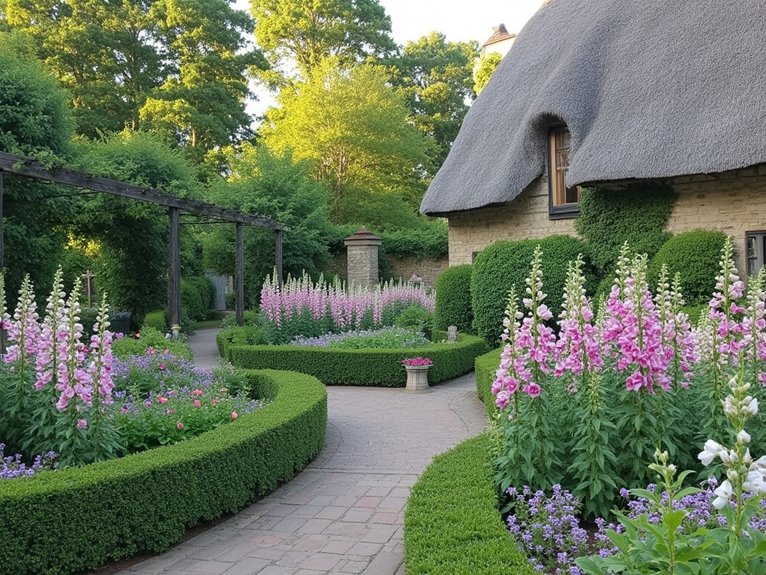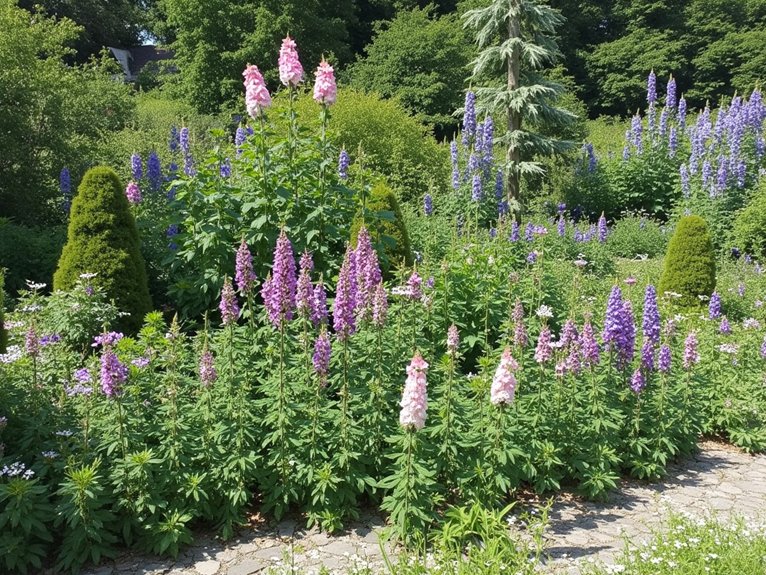A cottage garden brings the romance of English countryside living to any home’s landscape. Experts note that “successful cottage gardens blend structure with wild abundance,” according to master gardener Sarah Thompson. While anyone can toss together flowering plants, creating that coveted cottage look requires strategic plant selection and placement. The right combination of flowering shrubs, climbing vines, and perennial flowers transforms an ordinary garden into an enchanting retreat – but which plants will create that perfect balance?
Contents
- 1 Understanding the Cottage Garden Style
- 2 Creating Structure With Trees and Tall Plants
- 3 Adding Year-Round Interest With Flowering Shrubs
- 4 Selecting Show-Stopping Perennials
- 5 The Art of Plant Layering and Placement
- 6 Best Edible Plants for Your Cottage Garden
- 7 Maintaining Your Garden Through the Seasons
Understanding the Cottage Garden Style

While modern gardens often feature rigid designs and perfect symmetry, a cottage garden embraces a more relaxed and romantic approach to landscaping. The cottage garden aesthetics blend carefully selected plants with seemingly wild, scattered growth patterns that create an enchanting, lived-in atmosphere.
To achieve this style, gardeners layer their plantings strategically, starting with trees and shrubs as anchors, then incorporating perennials and wildflower integration throughout. The garden evolves naturally through the seasons, with plants intermingling and self-seeding to create that coveted, carefree look. It’s a style that celebrates both planned elements and nature’s spontaneity.
Creating Structure With Trees and Tall Plants
Although cottage gardens appear naturally wild and carefree, their essential structure comes from carefully positioned trees and tall plants. Tree selection starts with choosing specimens that match your garden’s size and climate zone.
For ideal height variety, combine towering trees like Flowering Dogwood (up to 40 feet) with mid-height options like Crape Myrtle (25 feet) and compact choices like Amur Maple (20 feet). “The key is creating layers that draw the eye upward while maintaining proportion,” notes garden expert Sarah Wilson. Position trees first along borders and corners, then add tall perennials like Delphinium and Foxglove to fill middle spaces.
Adding Year-Round Interest With Flowering Shrubs

Since flowering shrubs form the backbone of a cottage garden, selecting varieties that offer multi-season interest creates lasting beauty throughout the year. Camellias provide winter blooms with glossy evergreen foliage, while boxwoods offer structure and versatility for creating garden divisions or topiaries.
For reliable seasonal blooms, incorporate hydrangeas that flower from summer through fall, and forsythia for early spring yellow blossoms. Gardenias add fragrant white flowers in summer, while roses deliver classic cottage charm from late spring until frost. These flowering varieties guarantee your garden remains vibrant across all seasons.
Selecting Show-Stopping Perennials
Building upon the foundation created by flowering shrubs, perennials bring reliable, long-lasting color and charm to cottage gardens year after year. When planning perennial selection, focus on tried-and-true favorites like delphiniums, foxgloves, and columbines that return reliably each season.
Create dynamic plant combinations by mixing heights and bloom times. Place taller perennials like 4-6′ delphiniums toward the back, while 2-3′ columbines work perfectly in middle zones. Include low-growing varieties in front borders. “Successful cottage gardens layer perennials to guarantee continuous blooming from spring through fall,” notes garden expert Sarah Mitchell.
The Art of Plant Layering and Placement

The thoughtful placement of plants in distinct layers creates the signature cottage garden look that’s both beautiful and functional. Successful plant combinations start with tall trees forming the highest layer at 15-40 feet, followed by shrubs at 6-12 feet that provide year-round structure. Mid-height perennials like delphiniums and foxgloves, ranging from 3-6 feet, create dramatic height variation in the middle layer. The lowest layer features ground covers and compact plants under 2 feet tall.
As garden designer Sarah Thompson notes, “Layer your plants from tallest to shortest, ensuring each one receives adequate sunlight and space to thrive.”
Best Edible Plants for Your Cottage Garden
Incorporating edible plants into your cottage garden creates a beautiful and practical space that nourishes both body and soul. The Ambrosia apple tree, reaching 12-15 feet tall, offers sweet fruits while adding vertical interest. Fruit-bearing shrubs like blueberries and raspberries provide tasty harvests and year-round structure.
For lower layers, mix seasonal vegetables among flowering perennials. Plant compact tomatoes, rainbow chard, and climbing peas alongside roses and delphiniums. Herbs like thyme, sage, and lavender add both culinary value and fragrant blooms while attracting beneficial pollinators to your edible paradise.
Maintaining Your Garden Through the Seasons
Successfully maintaining a cottage garden requires dedicated attention to seasonal changes and timely care throughout the year. Seasonal maintenance tasks include pruning trees and shrubs in late winter, dividing perennials in spring, and removing spent blooms throughout summer.
Weather considerations play an important role in garden health. During hot months, plants need consistent watering schedules, while fall calls for cleanup of fallen leaves and protecting tender plants. Winter maintenance focuses on structural care – pruning dead branches and protecting plants from frost damage.
Expert gardeners recommend creating a monthly checklist to track essential tasks and monitor plant health through each season.
